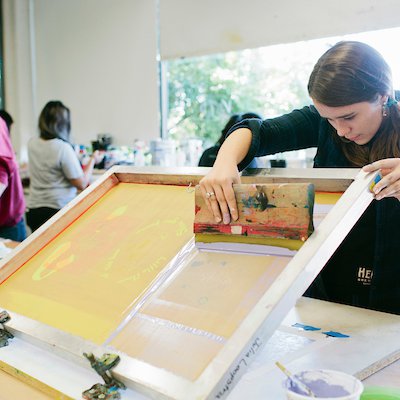ChatGPT said: How 10:9 Design Screen Printing can elevate your event presence
Wiki Article
The Crucial Guide to Understanding Screen Printing and Its Versatile Utilizes
Screen printing has an abundant background that goes back to old times, developing right into a sophisticated strategy utilized across different sectors today. This overview discovers the intricacies of the screen printing process, detailing its applications in home, style, and advertising and marketing design - 10:9 Design Screen Printing Texas. Comprehending these basics can open up innovative potential for both commercial and artistic tasks. The adhering to areas will reveal important suggestions and methods to enhance one's screen printing endeavorsThe History of Screen Printing
Screen printing has origins that trace back centuries, its evolution reflects the creative and technical improvements of different cultures. Originating in ancient China, the technique was originally utilized for decorating fabrics and later spread to Japan, where it ended up being indispensable to Ukiyo-e woodblock printing. The technique shifted to Europe in the 18th century, where it gained appeal amongst artisans and business printers. The development of image solution in the 20th century transformed screen printing, permitting more intricate layouts and higher effectiveness. Artists like Andy Warhol better drove its popularity, using the tool to produce famous works that combined commercialism and art. By the late 20th century, screen printing had actually established itself as a versatile method, utilized in vogue, marketing, and art. Today, it proceeds to progress, integrating electronic innovation and broadening its applications across different sectors.The Screen Printing Process Explained
Screen printing transforms imaginative visions into concrete styles via a series of accurate actions. Originally, an image is produced and after that moved onto a screen, usually constructed from fine mesh fabric extended over a structure. A light-sensitive solution is put on the screen, which is exposed to light, solidifying in locations not covered by the photo. After cleaning out the unhardened solution, a pattern is formed.Next, the screen is placed over the substrate, whether it be material, paper, or one more material. Ink is then pushed with the open locations of the pattern utilizing a squeegee, transferring the style onto the substratum listed below. This procedure can be duplicated for numerous shades, calling for different displays for each hue. The printed item is cured utilizing warm to assure the ink sticks effectively, resulting in a durable, vibrant layout all set for usage.
Sorts Of Screen Printing Techniques

In addition, specialty strategies, such as discharge screen printing, eliminate dye from the fabric to produce softer prints, while aluminum foil screen printing uses metal aluminum foil to attain a shiny finish (10:9 Design Texas). Each method uses distinctive qualities, providing to numerous imaginative demands and manufacturing scales, inevitably broadening the opportunities within the screen printing domain
Applications of Screen Printing in Different Industries

In addition, the signs and advertising and marketing markets make use of screen printing for developing attractive screens and banners. This method permits bold shades and detailed layouts that record focus. In electronic devices, screen printing is used for using conductive inks to circuit card, necessary for part links. Moreover, the home design market welcomes screen printing to generate distinct layouts on textiles and wall art. Generally, screen printing acts as an essential tool across diverse fields, boosting items with individualized and aesthetically attractive graphics.
Tips for Successful Screen Printing Projects
While carrying out a screen printing task, mindful attention to detail can substantially boost the final outcome. Choosing high-quality products is vital; this includes the screen, inks, and substratums. Using ideal mesh counts can influence ink deposition and detail resolution. Prep work is equally crucial; extensive cleaning of displays and proper direct exposure times guarantee crisp prints.Next off, accurate enrollment is crucial for multi-color prints. Utilizing alignment tools can aid achieve exact layering. Additionally, testing prints on scrap products before production helps determine possible issues without squandering sources.

Often Asked Questions
What Products Are Best for Screen Printing on Textile?
Cotton and polyester blends are suitable for screen printing on fabric as a result of their toughness and ink absorption. Additionally, specialized fabrics like silk or canvas can generate special textures and coatings, enhancing the total design top quality.How Do I Tidy and Maintain Screen Printing Devices?
To maintain and clean up screen printing equipment, one must routinely clean screens with ideal solvents, check mops for wear, lubricate relocating components, and store all products in a completely dry, dust-free environment to lengthen their lifespan.What Are the Environmental Influences of Screen Printing?
Screen printing can have substantial environmental effects, consisting of chemical waste from solvents and inks, water usage during cleansing procedures, and energy usage. Sustainable methods and green materials are necessary for minimizing these unfavorable results.Can Screen Printing Be Done at Home Efficiently?
Screen printing can be properly done at home with the right materials and techniques. Enthusiasts can develop top quality prints, though success depends on their skill level, devices, and understanding of the procedure entailed.
What Are the Prices Related To Beginning a Screen Printing Company?

Starting a screen printing company involves expenses for equipment, materials, and workspace. Initial costs usually vary from a couple of hundred to numerous thousand bucks, depending upon the scale, top quality of equipment, and preferred production capacity.
Screen printing has an abundant background that dates back to old times, progressing into a sophisticated technique made use of throughout different markets today. Another method, rotary screen printing, uses cylindrical displays, promoting constant printing on textile rolls, consequently enhancing performance for massive manufacturings. Furthermore, specialized methods, such as discharge screen printing, get rid of dye from the textile to develop softer prints, while foil screen printing uses metallic aluminum foil to accomplish a glossy surface. In the fashion market, screen printing is widely made use of to create vibrant styles on garments, allowing brand names to showcase their unique styles. Cotton and polyester blends are ideal for screen printing on material due to their resilience and ink absorption.
Report this wiki page